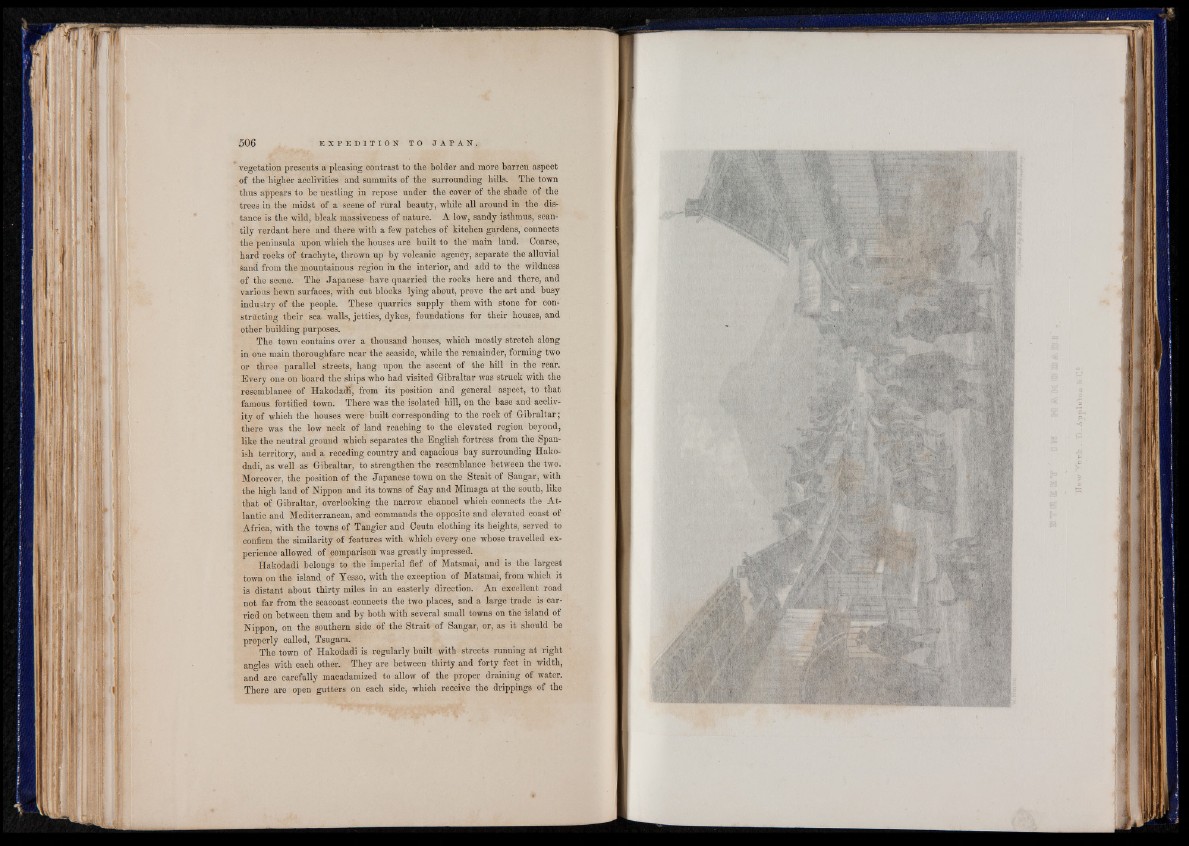
vegetation presents a pleasing contrast to the bolder and more barren aspect
of the higher acclivities and summits of the surrounding hills. The town
thus appears to be nestling in repose under the cover of the shade of the
tree3 in the midst of a scene of rural beauty, while all around in the distance
is the wild, bleak massiveness of nature. A low, sandy isthmus, scantily
verdant here and there with a few patches of kitchen gardens,' connects
the peninsula upon which the houses are built to the main land. Coarse,
hard rocks of trachyte, thrown up by volcanic agency, separate the alluvial
Sand from the mountainous region in the interior, and add to the wildness
of the scene. The Japanese have quarried the rocks here and there, and
various hewn surfaces, with cut blocks lying about, prove the art and busy
industry of the people. These quarries supply them with stone for constructing
their sea walls, jetties, dykes, foundations for their houses, and
other building purposes.
The town contains over a thousand houses, which mostly stretch along
in one main thoroughfare near the seaside, while the remainder, forming two
or three parallel streets, hang upon the ascent of the hill in the rear.
Every one on board the ships who had visited Gibraltar was struck with the
resemblance of Hakodadi, from its position and general aspect, to that
famous fortified town. There was the isolated hill, on the base and acclivity
of which the houses were built corresponding to the rock of Gibraltar;
there was the low neck of land reaching to the elevated region beyond,
like the neutral ground which separates the English fortress from the Spanish
territory, and a receding country and capacious bay surrounding Hakodadi,
as well as Gibraltar, to strengthen the resemblance between the two.
Moreover, the position of the Japanese town on the Strait of Sangar, with
the high land of Nippon and its towns of Say and Mimaga at the south, like
that of Gibraltar, overlooking the narrow channel which connects the Atlantic
and Mediterranean, and commands the opposite and elevated coast of
Africa, with the towns of Tangier and Ceuta clothing its heights, served to
confirm the similarity of features with which every one whose travelled experience
allowed of comparison was greatly impressed.
Hakodadi belongs to the imperial fief of Matsmai, and is the largest
town on the island of Yesso, with the exception of Matsmai, from which it
is distant about thirty miles in an easterly direction. An excellent road
not far from the seacoast-connects the two places, and a large trade is carried
on between them and by both with several small towns on the island of
Nippon, on the southern side of the Strait of Sangar, or, as it should be
properly called, Tsugara.
The town of Hakodadi is regularly built with streets running at right
angles with each other. They are between thirty and forty feet in width,
and are carefully macadamized to allow of the proper draining of water.
There are open gutters on each side, which receive the drippings of the